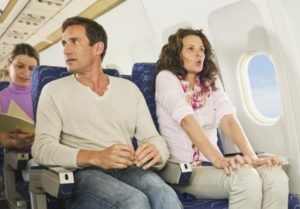
Photo: Travel3Sixty
Fear of Flying
Help me! I am scared of flying!
Careen Loo wrote to me by forwarding this Instagram video with screaming passengers https://tinyurl.com/27y52tcs
She asked me 3 questions:
1: Whether the turbulence was considered moderate or severe.
Well, I would classify this as severe turbulence. Turbulence is categorized into:
- Light – just small, momentary, fluctuations. Passengers may not feel much of anything except a slight strain against their seat belts
- Moderate – passengers may feel strains against the seatbelts but aircraft remains under control. Objects can be dislodged slightly. Walking would be difficult in the cabin.
- Severe – things start to get dicey. Passengers may be forced violently against their seat belts.
- Extreme turbulence – aircraft starts to be tossed around very violently. This is a very rare event. It can cause structural damage. The airplane may have flown into a squall line.
2: Is this dangerous and may cause the plane to lose control?
Turbulence is sometimes an unavoidable part of flying. It is not dangerous as long as you are securely fastened to the seat belts.
It is usually caused by unstable air in the atmosphere, much like a boat sailing through wavy waters or a bus ride along a road with pot holes.
Sometimes such discomfort could be due to rising air from the warm earth or a result of flying near to the jet streams.
Other times, turbulence is due to mountain waves caused by wind blowing across uneven surfaces.
Whatever the cause, a plane flying through this mass of unstable air will inevitably be jostled around but the plane is always under control of the pilot.
3: Would the pilots normally be nervous when such turbulence happened and was it safe for them to control the plane even though the turbulence was very bad?
Pilots are not nervous for they are used to experiencing turbulence as it is part and parcel of their daily flying.
Turbulence can often be detected by using the weather radar. As such, the captain would advise their passengers to have their seat belts on before encountering them.
I used to go one step further by advising passengers to have their seat belts securely fastened even when the warning signs are not on due to clear air turbulence which are more difficult to detect
There are safety precautions to be taken by the commander when he is expecting turbulence He would switch on the seat belts, reduce the aircraft speeds, request change of altitude or route and make an immediate announcement for all to be seated. Service of hot meals would also be stopped temporarily.
Normally, the plane will be under the control of the autopilot unless it is tripped by severe turbulence. The pilot would then safely take over control and re-engage the autopilot when the turbulence subsides.
Please read a similar article in my Blog here https://askcaptainlim.com/why-is-flying-on-an-airplane-so-nerve-racking/
You can view a YouTube video ‘What Is Turbulence? A Pilot Explains How It Happens, Even in Clear Skies’
here https://youtu.be/5wQ9nAlO12E